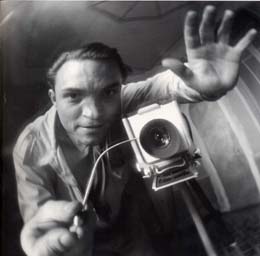
Catalá-Roca took his fist picture at the age of seven and began
to learn the craft from his father Pere Catalá i Pic.
From
an early age, Francesc had the privilege of seeing pictures and exhibitions
by leading photographers. He was thus able to perfect his technique and
acquire a culture beggage that opened up new perspective. He collaborated
with his father on producing several collages, and he also did a few himself.
Simply by working, he began to be slective, to know what he wanted to
do and what he would never do. It was inusual before the second quarter
of the twentieth century, to come across a photographer who did not want
to be a painter. He perfected his craft and made it his profession, and
he lived be it and for it.
After
the Spanish Civil War, during Franco's Dictatorship, Catalá-Roca
travelled extensively throughout Spain; he was an eye witness to the changes
that slowly transformed the country; and he frequented groups of artists
and intellectuals, who influenced him and on whom he too had an influence.
In
his photographs, Catalá-Roca reflected on the period and the events
through which he lived, and was very act of an image to inform.
Catalá-Roca
creates a new awareness of photography. His images re-establish the harmony
between the perceiver and the very act of pereicing. He achieves this
balance through his highly personal aesthetic, -angles of vision, framings
inherited from the classical avant-gardes.- and through his imperative
need to inform us of time passing inexorably and of memory.
A
repository of the images of his era, Catalá-Roca's vision offers
these images to us after they have been filtered byhis view oh the world,
a filter that does not interfere in his ethical desie to stand aside,
as it were, without either altering or dostorting the information provided.
Fifty
years of Spanish life are seen and experienced by the photographer and
acknowledged in his photographs.